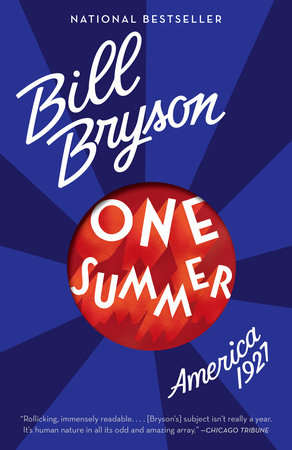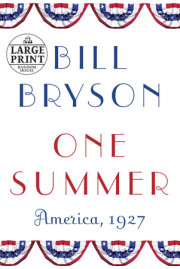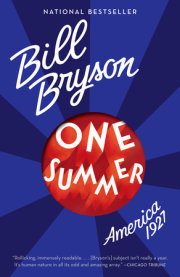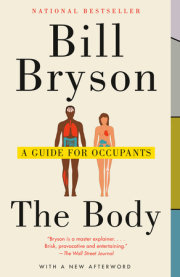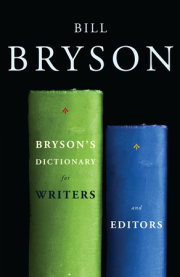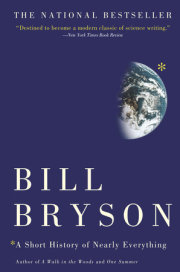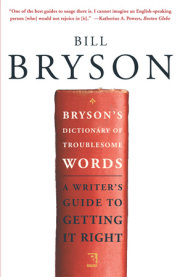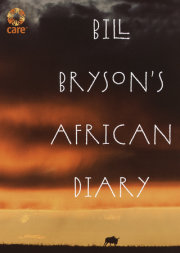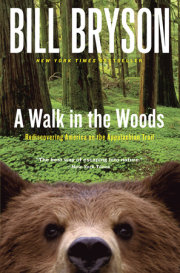Excerpted from the Hardcover Edition 1
Ten days before he became so famous that crowds would form around any building that contained him and waiters would fight over a corncob left on his dinner plate, no one had heard of Charles Lindbergh. The New York Times had mentioned him once, in the context of the coming Atlantic flights. It had misspelled his name.
The news that transfixed the nation as spring gave way to summer in 1927 was a gruesome murder in a modest family home on Long Island, coincidentally quite close to Roosevelt Field, where the Atlantic fliers were now gathering. The newspapers, much excited, called it the Sash Weight Murder Case.
The story was this: Late on the night of March 20, 1927, as Mr. and Mrs. Albert Snyder slept side by side in twin beds in their house on 222nd Street in a quiet, middle-class neighborhood of Queens Village, Mrs. Snyder heard noises in the upstairs hallway. Going to investigate, she found a large man—a “giant,” she told police—just outside her bedroom door. He was speaking in a foreign accent to another man, whom she could not see. Before Mrs. Snyder could react, the giant seized her and beat her so roughly that she was left unconscious for six hours. Then he and his confederate went to Mr. Snyder’s bed, strangled the poor man with picture wire, and stove in his head with a sash weight. It was the sash weight that fired the public’s imagination and gave the case its name. The two villains then turned out drawers all over the house and fled with Mrs. Snyder’s jewels, but they left a clue to their identity in the form of an Italian-language newspaper on a table downstairs.
The New York Times the next day was fascinated but confused. In a big page-one headline it reported:
Art Editor Is Slain in Bed;
Wife Tied, Home Searched;
Motive Mystifies Police
The story noted that a Dr. Vincent Juster from St. Mary Immaculate Hospital had examined Mrs. Snyder and couldn’t find any bump on her that would explain her six hours of unconsciousness. Indeed, he couldn’t find any injuries on her at all. Perhaps, he suggested tentatively, it was the trauma of the event rather than actual injury that accounted for her prolonged collapse.
Police detectives by this time, however, were more suspicious than confused. For one thing, the Snyder house showed no sign of forced entry, and in any case it was an oddly modest target for murderous jewel thieves. The detectives found it curious, too, that Albert Snyder had slept through a violent scuffle just outside his door. The Snyders’ nine-year-old daughter, Lorraine, in a room across the hall, had also heard nothing. It also seemed strange that burglars would break into a house and evidently pause to read an anarchist newspaper before placing it neatly on a table and proceeding upstairs. Oddest of all, Mrs. Snyder’s bed—the one from which she had arisen to investigate the noise in the hallway—was tidily made, as if it had not been slept in. She was unable to account for this, citing her concussion. As the detectives puzzled over these anomalies, one of them idly lifted a corner of mattress on Mrs. Snyder’s bed and there revealed the jewels that she had reported stolen.
All eyes turned to Ruth. She met the detectives’ gazes uncertainly, then broke down and confessed the crime—but blamed it all on a brute named Judd Gray, her secret lover. Ruth Snyder was placed under arrest, a search was begun for Judd Gray, and the newspaper-reading public of America was about to become uncommonly excited.
The 1920s was a great time for reading altogether—very possibly the peak decade for reading in American life. Soon it would be overtaken by the passive distractions of radio, but for the moment reading remained most people’s principal method for filling idle time. Each year, American publishers produced 110 million books, more than 10,000 separate titles, double the number of ten years before. For those who felt daunted by such a welter of literary possibility, a helpful new phenomenon, the book club, had just made its debut. The Book-of-the-Month Club was founded in 1926 and was followed the next year by the Literary Guild. Both were immediately successful. Authors were venerated in a way that seems scarcely possible now. When Sinclair Lewis returned home to Minnesota to work on his novel Elmer Gantry (published in the spring of 1927), people came from miles around just to look at him.
Magazines boomed, too. Advertising revenues leaped 500 percent in the decade, and many publications of lasting importance made their debut: Reader’s Digest in 1922, Time in 1923, the American Mercury and Smart Set in 1924, The New Yorker in 1925. Time was perhaps the most immediately influential. Founded by two former Yale classmates, Henry Luce and Briton Hadden, it was very popular but wildly inaccurate. It described Charles Nungesser, for instance, as having “lost an arm, a leg, a chin” during the war, which was not merely incorrect in all particulars but visibly so since Nungesser could be seen every day in newspaper photographs with a full set of limbs and an incontestably bechinned face. Time was noted for its repetitious devotion to certain words—swart, nimble, gimlet-eyed—and to squashed neologisms like cinemaddict and cinemactress. It also had a fondness for odd, distorted phrases, so that “in the nick of time” became, without embarrassment, “in time’s nick.” Above all, it had a curious Germanic affection for inverting normal word order and packing as many nouns, adjectives, and adverbs as possible into a sentence before bringing in a verb—or as Wolcott Gibbs put it in a famous New Yorker profile of Luce, “Backward ran the sentences until reeled the mind.” Despite their up-to-the-minute swagger, Luce and Hadden were deeply conservative. They would not, for instance, employ women for any job above the level of secretary or office assistant.
Above all, the 1920s was a golden age for newspapers. Newspaper sales in the decade rose by about a fifth, to 36 million copies a day—or 1.4 newspapers for every household. New York City alone had twelve daily papers, and almost all other cities worthy of the name had at least two or three. More than this, in many cities readers could get their news from a new, revolutionary type of publication that completely changed people’s expectations of what daily news should be—the tabloid. Tabloids focused on crime, sports, and celebrity gossip, and in so doing gave all three an importance considerably beyond any they had enjoyed before. A study in 1927 showed that tabloids devoted between a quarter and a third of their space to crime reports, up to ten times more than the serious papers did. It was because of their influence that the quiet but messy murder of a man like Albert Snyder could become national news.
The tabloid, both as a format and as a way of distilling news down to its salacious essence, had been around for a quarter of a century in England, but no one had thought to try it in the United States until two young members of the Chicago Tribune publishing family, Robert R. McCormick and his cousin Joseph Patterson, saw London’s Daily Mirror while serving in England during World War I and decided to offer something similar at home when peace came. The result was the Illustrated Daily News, launched in New York in June 1919, price 2 cents. The concept was not an immediate hit—circulation at one point was just eleven thousand—but gradually the Daily News built a devoted following and by the mid-1920s it was far and away the best-selling newspaper in the country, with a circulation of one million, more than double that of the New York Times.
Such success inevitably inspired imitators. First came the New York Daily Mirror from William Randolph Hearst in June 1924, followed three months later by the wondrously dreadful Evening Graphic. The Graphic was the creation of an eccentric, bushy-haired businessman named Bernarr Macfadden, who had started life rather more prosaically some fifty years earlier as a Missouri farmboy named Bernard MacFadden. Macfadden, as he now styled himself, was a man of strong and exotic beliefs. He didn’t like doctors, lawyers, or clothing. He was powerfully devoted to bodybuilding, vegetarianism, the rights of commuters to a decent railroad service, and getting naked. He and his wife frequently bemused their neighbors in Englewood, New Jersey—among them Dwight Morrow, a figure of some centrality to this story, as will become apparent—by exercising naked on the lawn. Macfadden’s commitment to healthfulness was so total that when one of his daughters died of a heart condition he remarked: “It’s better she’s gone. She’d only have disgraced me.” Well into his eighties he could be seen walking around Manhattan carrying a forty-pound bag of sand on his back as a way of keeping fit. He lived to be eighty-seven.
As a businessman, he seems to have dedicated his life to the proposition that where selling to the public is concerned no idea is too stupid. He built three separate fortunes. The first was as the inventor of a cult science he called Physcultopathy, which featured strict adherence to his principles of vegetarianism and strength through bodybuilding, with forays into nakedness for those who dared. The movement produced a chain of successful health farms and related publications. In 1919, as an outgrowth of the latter, Macfadden came up with an even more inspired invention: the confession magazine. True Story, the flagship of this side of his operations, soon had monthly sales of 2.2 million. All the stories in True Story were candid and juicy, with “a yeasty undercurrent of sexual excitation,” in the words of one satisfied observer. It was Macfadden’s proud boast that not a word in True Story was fabricated. This claim caused Macfadden a certain amount of financial discomfort when a piece in 1927 called “The Revealing Kiss,” set in Scranton, Pennsylvania, turned out, by unfortunate chance, to contain the names of eight respectable citizens of that fair city. They sued, and Macfadden was forced to admit that True Stories’ stories were not in fact true at all and never had been.
When tabloids became the rage, Macfadden launched the Evening Graphic. Its most distinguishing feature was that it had almost no attachment to truth or even, often, a recognizable reality. It conducted imaginary interviews with people it had not met and ran stories by figures who could not possibly have written them. When Rudolph Valentino died in 1926, it produced a series of articles by him from beyond the grave. The Graphic became famous for a form of illustration of its own invention called the composograph, in which the faces of newsworthy figures were superimposed on the bodies of models who had been posed on sets to create arresting tableaux. The most celebrated of these visual creations came during annulment proceedings, earlier in 1927, between Edward W. “Daddy” Browning and his young and dazzlingly erratic bride, affectionately known to all as Peaches, when the Graphic ran a photo showing (without any real attempt at plausibility) Peaches standing naked in the witness box. The Graphic sold an extra 250,000 copies that day. The New Yorker called the Graphic a “grotesque fungus,” but it was a phenomenally successful fungus. By 1927, its circulation was nearing six hundred thousand.
For conventional newspapers, these were serious and worrying numbers. Most responded by becoming conspicuously more like tabloids themselves, in spirit if not presentation. Even the New York Times, though still devotedly solemn and gray, found room for plenty of juicy stories throughout the decade and covered them with prose that was often nearly as feverish. So now when a murder like that of Albert Snyder came along, the result across all newspapers was something like a frenzy.
It hardly mattered that the perpetrators were spectacularly inept—so much so that the writer Damon Runyon dubbed it the Dumbbell Murder Case—or that they were not particularly attractive or imaginative. It was enough that the case involved lust, infidelity, a heartless woman, and a sash weight. These were the things that sold newspapers. The Snyder-Gray case received more column inches of coverage than any other crime of the era, and was not exceeded for column inches until the trial of Bruno Hauptmann for the kidnapping of Charles Lindbergh’s baby in 1935. In terms of its effect on popular culture, even the Lindbergh kidnapping couldn’t touch it.
Trials in 1920s America were often amazingly speedy. Judd Gray and Ruth Snyder were arraigned, indicted by a grand jury, and in the dock barely a month after their arrest. A carnival atmosphere descended on the Queens County Courthouse, a building of classical grandeur in Long Island City. A hundred and thirty newspapers from across the nation and as far afield as Norway sent reporters. Western Union installed the biggest switchboard it had ever built—bigger than any used for a presidential convention or World Series. Outside the courthouse, lunch wagons set up along the curb and souvenir sellers sold stickpins in the shape of sash weights for ten cents each. Throngs of people turned up daily hoping to get seats inside. Those who failed seemed content to stand outside and stare at the building knowing that important matters that they could not see or hear were being decided within. People of wealth and fashion turned up, too, among them the Marquess of Queensberry and the unidentified wife of a U.S. Supreme Court justice.
Those fortunate enough to get seats inside were allowed to come forward at the conclusion of proceedings each day and inspect the venerated exhibits in the case—the sash weight, picture wire, and bottle of chloroform that featured in the evil deed. The News and Mirror ran as many as eight articles a day on the trial. If any especially riveting disclosures emerged during the day—that, for instance, Ruth Snyder on the night of the murder had received Judd Gray in a blood-red kimono—special editions were rushed into print, as if war had been declared. For those too eager or overcome to focus on the words, the Mirror provided 160 photographs, diagrams, and other illustrations during the three weeks of the trial, the Daily News nearer 200. For a short while, one of Gray’s lawyers was one Edward Reilly, who would later gain notoriety by defending Bruno Richard Hauptmann in the Lindbergh baby kidnapping trial, but Reilly, who was a hopeless drunk, was fired or resigned at an early stage.
Each day for three weeks, jurors, reporters, and audience listened in rapt silence as the tragic arc of Albert Snyder’s mortal fall was outlined. The story had begun ten years earlier when Snyder, the lonely, balding art editor of Motor Boating magazine, had developed an infatuation with an office secretary of high spirits and light intellect named Ruth Brown. She was thirteen years his junior and not notably attracted to him, but when, after their third or fourth date, he offered her a gumball-sized engagement ring her modest defenses crumbled. “I just couldn’t give up that ring,” she explained helplessly to a friend.
Copyright © 2014 by Bill Bryson. All rights reserved. No part of this excerpt may be reproduced or reprinted without permission in writing from the publisher.

